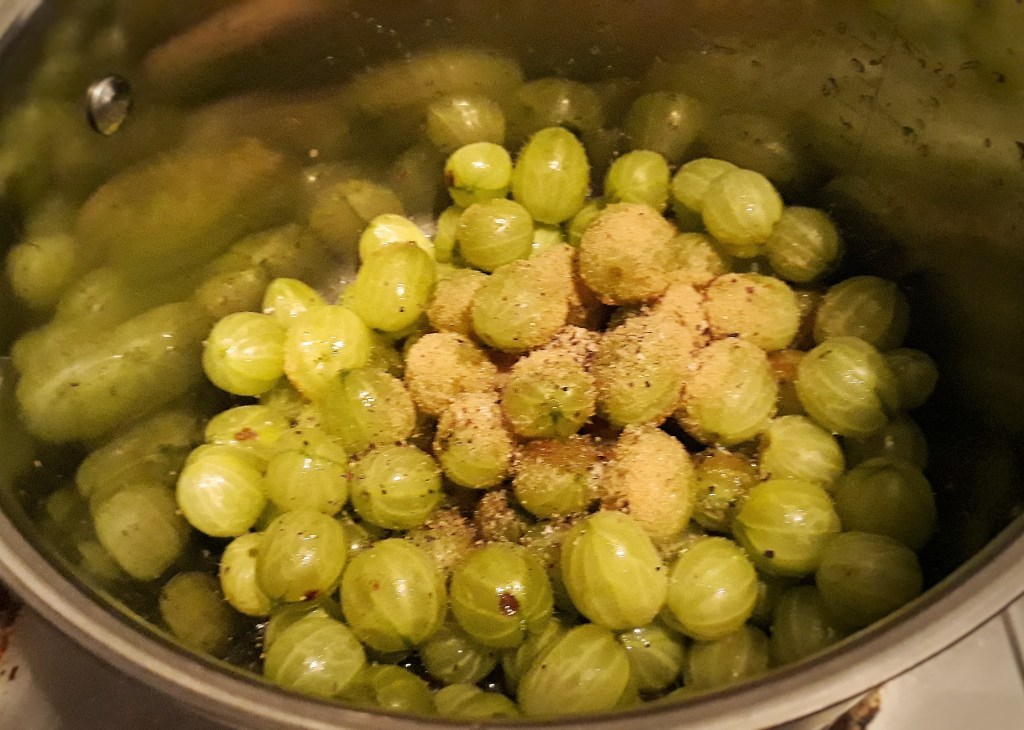Last post I wrote about the delicious gooseberry. Since I wrote it, I have seen them in quite a few shops, including Morrison’s, so I am feeling good about the gooseberry’s culinary future.

It is important to remember that gooseberries can be served with meat and fish in rather the same way as tart Bramley apples are: oily fish such as mackerel is the classic pairing, but I have found recipes that match it with chicken, goose, pork and mutton or lamb. Sauces and stuffings are made with the small new tart berries, with just a little sugar. The simplest sauce being made from halved berries, chopped mint and sugar. The ingredients are mixed, covered and left to macerate for several hours. Delicious with barbequed mackerel or herring, and the fact it isn’t cooked means the gooseberries retain their vibrant green colour.
I mentioned that in France it is known as the mackerel currant, because it is only ever really served with the oily fish, and even then, it’s considered particular only to Normandy. It did start life as an English dish, but as there was much communication between England and Normandy during the mediaeval period, it’s no surprise that they picked up some tips from the English during centuries of toing and froing.
I’ve taken elements from three different recipes to come up with mine: Jane Grigson’s English Food (1992), Eliza Acton’s Modern Cookery for Private Families (1847) and Elinor Fettiplace’s Receipt Book (1604). Talent borrows, genius steals and all that. Many of the ingredients are optional, so if you want a cleaner tasting sauce, omit the cream and maybe the butter too. If you are interested, there’s also a great recipe for a gooseberry stuffing for mackerel on my other blog.
It’s a delicious combination – simply grilled mackerel and the tart sauce, and maybe a green salad on the side. It’s telling you that summer is here! This pairing is largely forgotten now, but look in some older British cookery books and you’ll see it crop up again and again.
If you like the blogs and podcast I produce, please consider treating me to a virtual coffee or pint, or even a £3 monthly subscription: follow this link for more information.
Young, green, small gooseberries are required for recipes that are served with savoury food – the later, large sweet ones are best used in desserts (recipes for those coming soon).
250 g gooseberries, topped and tailed
50 ml water
50 ml white wine, or a dash of cider vinegar
50 g sugar, or to taste
good pinch of ground ginger
salt and pepper
a knob of butter (optional)
2 to 3 tbs double cream (optional)
Put the gooseberries, water, wine or vinegar and sugar in a saucepan and cook until the gooseberries go pale in colour and start to become very soft, crushing them against the side of your pan with a wooden spoon. Season with salt and pepper.

If you want a very smooth sauce with no seeds or pulp, whizz the whole thing in a blender and pass through a sieve. I like to leave mine with some texture, but it’s up to you. If you did pass it through a sieve put it in a clean pan and put it over a medium heat.
Smooth or pulpy, beat in your butter with whisk or spoon until it becomes glossy, then add the cream.

Add more sugar if you like – remember it isn’t supposed to be sweet like apple sauce.
Serve alongside grilled or fried mackerel, but also pork, chicken or goose.

Another classic!
LikeLiked by 1 person
Pingback: Gooseberry Jam | British Food: A History
Gooseberries and currants are definitely making a comeback over here in New England. Until the 1960s, they were actually banned here because they both are alternate hosts to white pine blister rust, which is deadly to our white pines. However, disease resistant varieties have been developed over time, and they are available to home gardeners to plant. Of course, many folks kept their currants in the back yard, so there’s always been a clandestine use of them!
LikeLiked by 1 person
I had no idea there was such a thing as a contraband gooseberry! Thanks very for your comment
LikeLiked by 1 person
Yes, for many decades. In fact, I think Ohio still has them banned!
LikeLiked by 1 person
I have two Ceylon gooseberry bushes in my garden. The fruit appears similar to that of your article except that they have a fuzzy skin and several seeds that must be removed for sauces. Also, they are very tart and require much sugar to become flavorful. Can these be prepared and used with your recipe?
LikeLiked by 1 person
Well I have never cooked with that fruit before, but I don’t see why not!
LikeLike